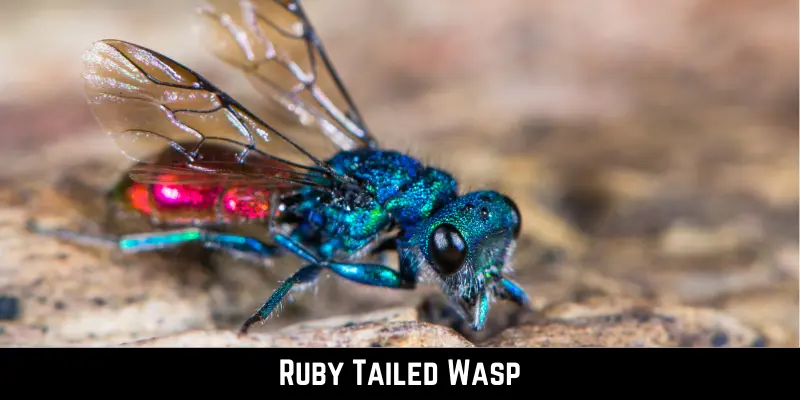Wasps are one of the most abundant household insects around the world. Everyone must have an encounter with these buzzing and irritating insects. However, have you ever seen ruby-colored wasps? These wasps could be ruby-tailed wasps.
Ruby-tailed wasps, also known as Chrysis Ignita, are a species of cuckoo wasps. These wasps are native to Central Europe and may present in some parts of Asia. They have a jewel-like appearance and ruby-colored abdomen. Moreover, they love to reside in gardens, meadows, and other relevant areas.
Are you an entomophile and enthusiastic to know about ruby-tailed wasps? Read the guidelines below to solve your queries.
What Is Ruby Tailed Wasp?
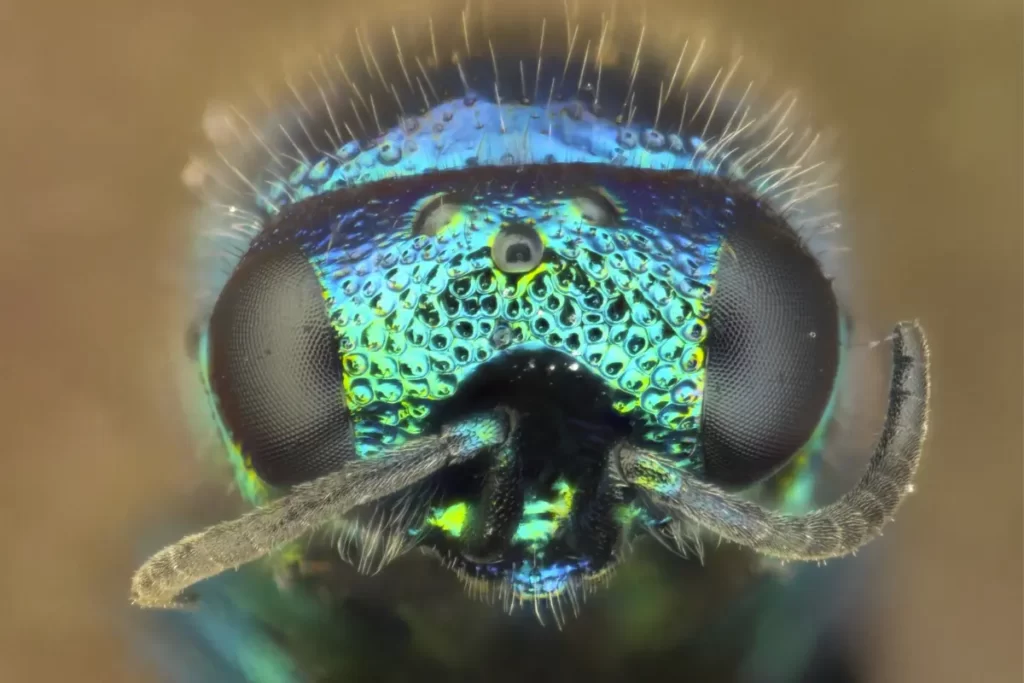
Ruby-tailed wasps are the species of cuckoo wasps commonly known as Chrysis Ignita. These beautiful metallic-colored insects belong to the family Chrysididae. They are present in the UK and continental Europe from Russia to China. According to the Royal Entomological Society, Chrysis Ignita is a complex species in North Europe with numerous sub-species.
These wasps are found in sunny areas next to walls, quarries, exposed rock sides, and around dead wood due to the overlapping of their habitat with hosts. They also love to reside in gardens, meadows, and woodlands. Moreover, these wasps are solitary wasps and dependent on their host.
Furthermore, these parasitoid wasps lay their eggs in the host’s nest, especially Mason bees and wasps. That’s why they are also known as cuckoo wasps.
| Taxonomy | |
| Kingdom | Animalia |
| Division | Arthropoda |
| Class | Insecta |
| Order | Hymenoptera |
| Family | Chrysididae |
| Genus | Chrysis |
| Species | C. Ignita |
| Scientific Name | Chrysis Ignita |
| Size (Adult; Length) | 10 to 12mm |
| Colors | Metallic |
| Descriptors | Metallic-colored solitary wasps used to live in the UK and Europe |
How Do You Identify a Ruby-Tailed Wasp?
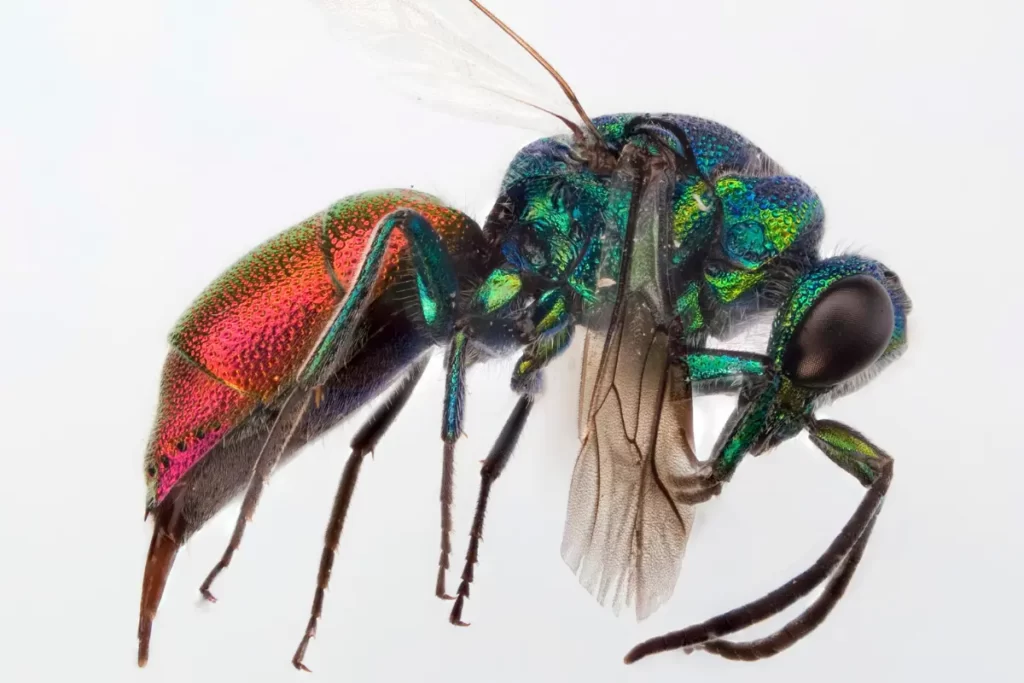
To identify the ruby-tailed wasp, you must know their specific feature. Ruby-tailed wasps are a group of metallic-colored insects. They have different ranges of color, including shiny red, green, blue, and bronze. All these colors shine in the sunlight. However, their abdomen is deep-ruby red colored.
Contrarily, their exoskeleton has a golf ball-like appearance with multiple projections and dimples ranging from micrometers to millimeters in size. These wasps are tiny insects ranging in size from 10-12mm in length. They have a black head with large compound eyes.
Moreover, an essential identification of these wasps is their transparent wings with some iridescence. Additionally, their abdomen contains sharply pointed tooth-like structures. The abdomen’s bottom surface is concave, allowing them to roll on a threat.
Where Do Ruby-Tailed Wasps Live?

Ruby-tailed wasps are a group of parasitic wasps found in various parts of the world, including North America, Europe, England, Britain, and Ireland. As these wasps are dependent on their hosts for survival, you can find them near walls, bare cliff faces, and in dead places in sunny areas.
Moreover, they also love to reside in gardens, meadows, woodlands, and urban areas. These wasps are also solitary insects, so they live in pre-existing cavities or burrows created by other insects, such as beetles or solitary bees.
Additionally, these wasps are famous for their unique behavior of parasitizing the nests of other bees and wasps, making them useful for ecological studies. Above all, the exact space and location of ruby-tailed wasps can vary depending on the specific species and region.
What Is the Life History of Ruby-Tailed Wasps?
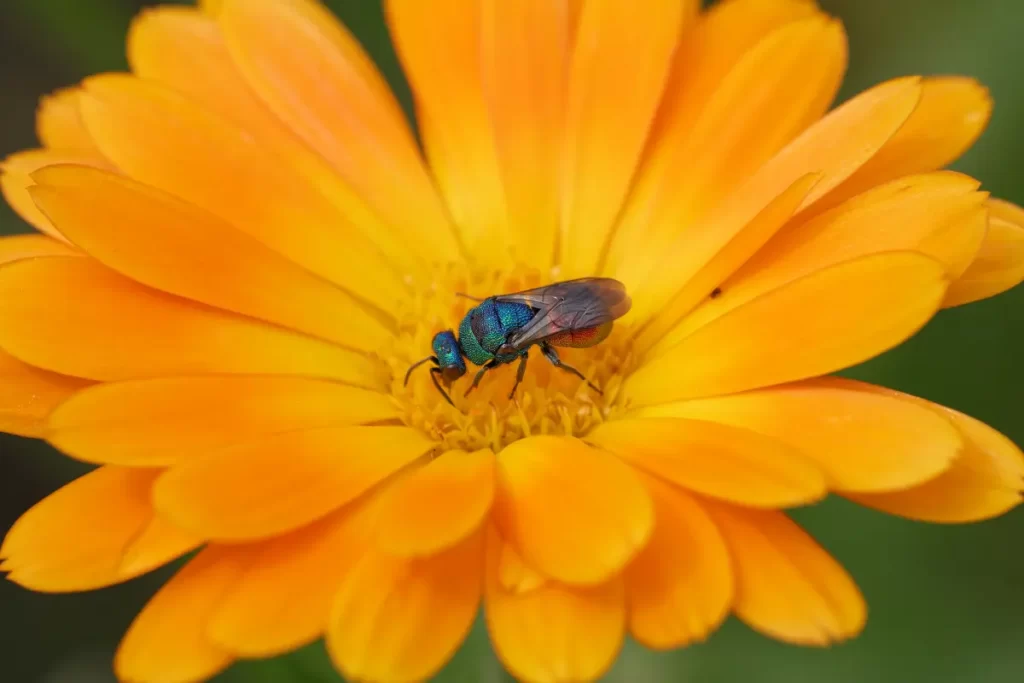
Ruby-tailed wasps are known for their distinct coloration. Below are the stages of their life history:
Infiltration and Egg Implantation
Chrysis Ignita, or ruby-tailed Wasp, is both parasite and kleptoparasite. The female ruby-tailed wasp possesses a long and telescopic ovipositor. According to Science Direct, female wasps deposit eggs inside the nest host wasp using an ovipositor. To find their host, female ruby-tailed wasps hide nearby.
Moreover, she used to hunt for wasps that dig burrows, pull victims, or return food to their nests. After that, she observes the nest until the hosts leave or attack its prey.
Parasitism
It is a relationship between a host and a parasite. A parasite is an insect that depends on another animal called the host. Ruby-tailed wasps use two strategies for parasitizing their hosts. In the first one, the cuckoo wasp consumes host eggs after hatching, then finishes the food in the nest.
In the second one, the cuckoo wasp waits until the host larva reaches the prepupal stage before killing it and removing all food supplies from the nest. These wasps use the second strategy when the host is the source of food and collect nectar and pollen.
Moreover, if the host wasp stores too much food for both the cuckoo wasp and its larvae, then the cuckoo wasp consumes only the food, leaving the larvae behind.
What Is the Morphology of Ruby-Tailed Wasps?
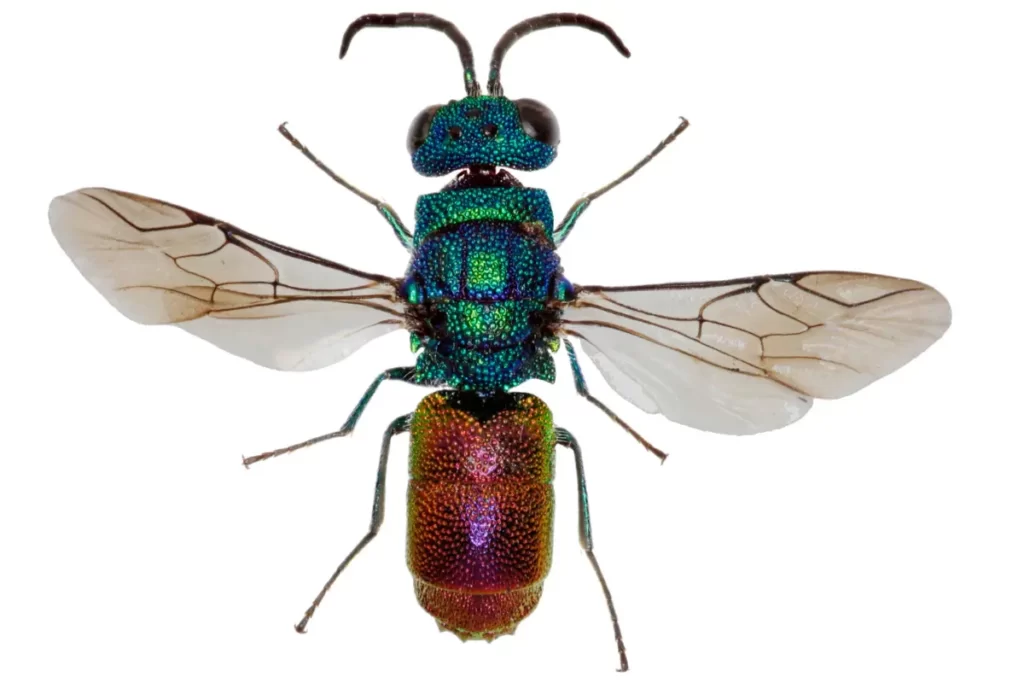
Besides their distinct coloration and compound eyes, ruby-tailed wasps have the following morphological characteristics.
Head
The head of the ruby-tailed wasp is generally flat and convex, with no noticeable grooves or ridges on the backside. Compared to other wasp families, all cuckoo wasps have a smaller occipital suture or groove at the rear of their head. Moreover, their compound eyes cover a significant part of their head.
Face
The front of the head distinguishes the ruby-tailed wasps from other species of their family. They have a long and thread-like antenna that is attached to their face. Furthermore, they have a unique structure called clypeus attached to their apex. The dorsal margin of the clypeus encircles the antennal socket.
Abdomen
The ruby-tailed wasps have three segmented abdomens. Due to their distinctive abdomens, it’s challenging to recognize their sex.
Generally, the waist of a ruby-tailed wasp is usually thin at the base and then gradually widens towards the posterior end. Each abdominal segment has a tube-like structure called a spiracle, which helps them in respiration.
Color
The ruby-tailed wasp is well-known for its distinct metallic coloration. They have different ranges of color, including green, blue, bronze, and shiny red. These colors are apparent on their abdomens and then reduced to bands and stripes on the legs, mandibles, and antennae.
However, their color can vary based on environment, temperature, and humidity.
Life Cycle of Ruby-Tailed Wasp

The life cycle of ruby-tailed wasps consists of different stages. They used to start their life cycle as adults. The adult ruby-tailed wasps are active during the summer and feed on nectar and pollen. Their primary role is to mate and reproduce.
On the other hand, female wasps search the nests of other solitary wasps to lay their eggs. After hatching eggs, their larvae feed on their host’s larvae; then, they enter the pupal stage to transfer into adult wasps. Now, these adult wasps are ready to repeat the cycle.
The life cycle of ruby-tailed wasps plays an essential role in controlling the population of other solitary bees through parasitism. This behavior has an ecological importance in maintaining the ecosystem.
What Is the Best Time to See a Ruby-Tailed Wasp?

Generally, ruby-tailed wasps are active during the summer due to the activation of their preferred hosts. They are most likely to be seen from late spring to early autumn in most temperate regions.
A warm and sunny day is the best time to see a ruby-tailed wasp. You can find them in your walls, trees, and yards from April to September.
Moreover, they are more active during the daytime, especially in the late morning and early afternoon when the temperature is higher. However, specific sights can depend on your location and climate. If you are eager to see the ruby-tailed wasp, it’s a good idea to talk with a local entomologist with specific information about their behavior.
Is Ruby-Tailed Wasp Harmful?
No, ruby-tailed wasps are not harmful. In the realm of wasps, the female wasp used to sting people. The sting of female ruby-tailed wasps is not functional and reduced to a tiny structure. However, if these wasps feel unsafe and if you try to tease them, they won’t stop themselves from biting you.
Moreover, a long, thin appendage may sometimes extend from the tip of the female abdomen that you may confuse with a sting, but it’s not a stinger; that may be an ovipositor used to insert eggs in the host nest. Thus, these wasps don’t harm you until they feel threatened.
Are Ruby-Tailed Wasps Beneficial?
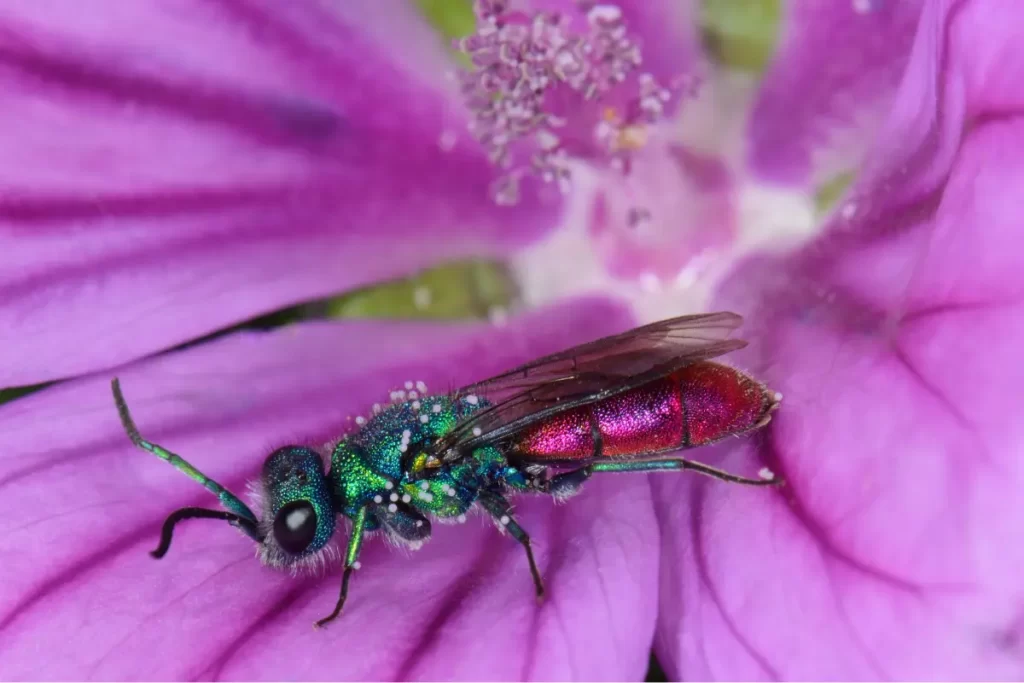
Yes, ruby-tailed wasps are very beneficial insects. They are parasitoid and consume the host larvae and food upon hatching their larvae. By parasitizing the larvae of other wasps or bees, they help control their population. This behavior is significant for agriculture settings where these solitary wasps are problematic.
Their primary focus is finding a suitable host, so they don’t sting humans until they feel threatened. They feed on nectar and pollen, so when they jump from one flower to another to collect nectar, they transfer pollen to other flowers and help pollinate.
Moreover, they contribute to the ecosystem’s biodiversity by interacting with other species in a complex manner. It can help in the overall maintenance of the ecosystem.
What Other Wasp Types Found in The USA?
There are many types found in the USA. You can find everything about these species here:
Final Verdict
Ruby-tailed or cuckoo wasps are commonly found in Europe, including England. These wasps are known for their distinct metallic coloration, like blue, red, and bronze, that shine in the sunlight. As these wasps have parasitic behavior and lay their eggs in the host’s nest, you may find them in tree trunks, grounds, and walls.
Moreover, these tiny wasps are more active in warm seasons, so that you can see them between April and September. Above all, their parasitic behavior helps control various insect populations and thus plays an essential role in the ecosystem.
References
Bergmann, T., Hadrys, H., Breves, G. & Schierwater, B. (2009) Character-based DNA barcoding: a superior tool for species classification. Berliner und Münchener Tierärztliche Wochenschrift Journal
